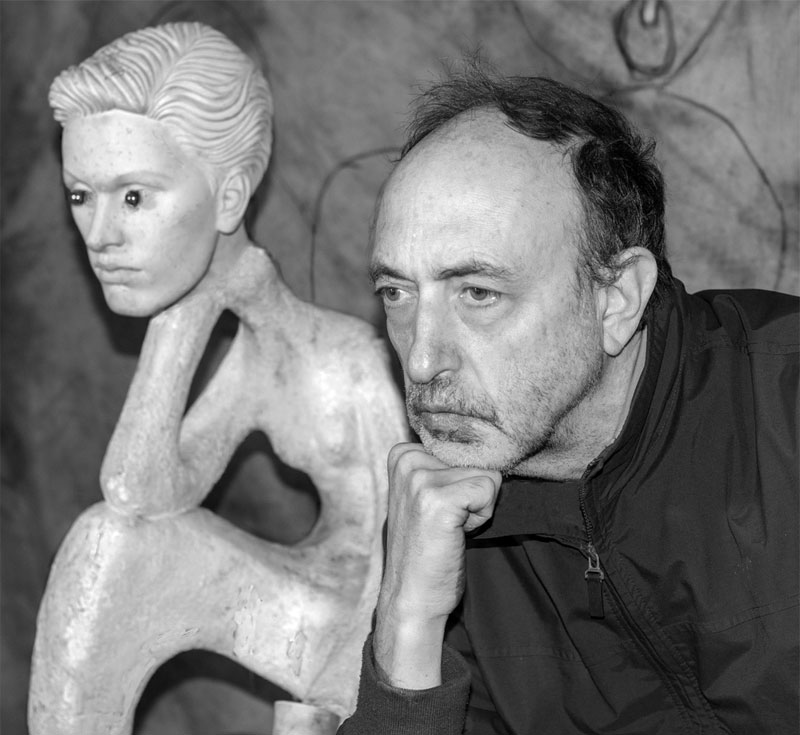American photographer Roger Ballen’s distinctive style of black and white images are mostly described as “weird” by viewers because of the provocative themes. People can now get a glimpse of his artis tic works at an ongoing show in Beijing. The exhibition hall of the art museum at the Central Academy of Fine Arts has been transformed into a graycolored theater like area. Ballen’s photos are either sus pended in the air or mounted on tilted wooden frames, some as high as 4 meters.
To echo the show’s title, Theater of the Absurd, Ballen has decorated a part of the area in the style of his pictures. Other than putting up his photos on the walls, he has painted the walls in parts, too, and has installed animal sculptures on the floor. There are chairs for visitors as well.
“It’s great! There are few times in my lifetime that things have been so interest ing,” the 66yearold photographer says about his first show in Beijing.
Every year, Ballen holds shows in differ ent cities across the world. But he calls the Beijing show “unique” as it tries to explore a more interactive space with the audience. Fan Di’an, president of the Central Acad emy of Fine Arts, says: “When I walk into the show space, I am both a visitor and an actor of the ‘theater’.”
Ballen’s works are a mix of drawings, installations and photography. His square photos always include wires, animals, dis carded stuff and graffiti on walls, bearing a distinctive aesthetic.
The show features photos he took in South Africa in the past 20 years as well as two videos, including the music video I Fink U Freeky that he codirected for the musical duo Die Antwoord.
Cai Meng, curator of the show, says he met Ballen in 2013 at the Pingyao Interna tional Photography Festival, where the Johannesburgbased artist won the big gest award of the festival in North China’s Shanxi province.
“Many contemporary Chinese photog raphers are influenced by him,” says Cai.
Ballen was born in New York and moved to Johannesburg in the 1970s.
He started his work in South Africa as a geologist and then kept recording life in towns and villages by taking photos, with portraits being his main subjects. Since 2000, Ballen has changed his approach to tableaux, an abstract way of photography that combines installations, sculptures, films and photography.
It’s common to see animals in his pictures — rats, birds, geese, snakes and even lions are included in his “crew” list since Ballen calls himself the director of his photos.
“Birds fly fast. Cats are the worst to con trol. I just take photos spontaneously when they move, maybe a good one or not. It all happens naturally,” says Ballen.
“I can speak cat language in order to know what they’re thinking. But cats never tell me what they want,” he says, jokingly.
Animals in his pictures add a sense of reality into his fictionalized visual works, he explains.
Ballen says each picture needs thou sands of steps for preparation, even though the shooting takes only 15 minutes sometimes.
To set up a backdrop for his photos, he visited numerous flea markets in different parts of the world, hunting for things he wanted for his filming.
Prior to his Beijing show, he spent days visiting flea markets here looking for stuff he needed to build his “set” for the show.
“I’m a world expert on flea markets now. But it’s hard to find something unique,” he says, revealing a sense of humor, which can sometimes be seen in his works.
On the theme of his Beijing show, he says it is through “absurdity” that he understands life. Life is meaningless, he says philosophically. No matter what we do, we can’t change our destinies.
Cai, the curator, says Ballen expresses the workings of the human mind, a con sistent style that the photographer has pursued in his pictures to reflect people’s thoughts.
Ballen’s strong love for black and white images goes back 50 years to when he first used cameras to take portraits of people. The simple aesthetic approach followed through his career.
“It’s not simply black and white. There are lots of grays in between,” he says.


Comments are closed.